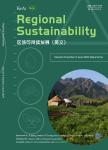Effect of future climate change on the water footprint of major crops in southern Tajikistan
Effect of future climate change on the water footprint of major crops in southern Tajikistan作者机构:State Key Laborutory of Desert and OasisXinjiang Instinite of Fcology and GeographyChinese Academy of Sciences Urmgi830011China University of Chinese Acadeny of SciencesBeijing 100049China Instinite of Water ProblemsHydropower and Rcology of the Academy of Sciences of the Repubic of Taikisan Dushanbe734042Tajikistan Research Center for Ecology and Emironment of Central AsiaChinese Acadmy of SciencesUrumqi830011China China-Pakistan Joint Research Center on Farth SciencesCAS-HECIslamabad 45320Pakistan
出 版 物:《Regional Sustainability》 (区域可持续发展(英文))
年 卷 期:2021年第2卷第1期
页 面:60-72页
学科分类:0830[工学-环境科学与工程(可授工学、理学、农学学位)] 0807[工学-动力工程及工程热物理] 09[农学] 090101[农学-作物栽培学与耕作学] 0901[农学-作物学]
基 金:supported by the National Natural Science Foundation of China(41761144079) the State's Key Project of Researchand Development Plan(2017YFC404501) the CAS Interdisplinary Imnnovation Team(JCTD201920) the Strategic Priority Research Program of the Chinese Academy of Sciences,the Pan-Third Pole Environment Study for a Green Silk Road(XDA20060303) the International Partneship Program of the Chinese Aademy of Sciences(131551KYSB20160002) the CAS Research Center for Ecologyand Environment of Central Asia(Y934031) the Regional Collaborative Innovation Project of Xinjiang Uygur Autonomous Region(2020E01010)
主 题:Optimal sowing date Representative concentration pathway Crop water requirement Statistical downscaling method Green water Blue water Southern Tajikistan
摘 要:Danghara,a major food production area in southern Tajikistan,is currently suffering from the impact of rapid climate change and intensive human *** the future impact of climate change on crop water requirements(CWRs)for the current growing period and defining the optimal sowing date to reduce future crop water demand are essential for local/regional water and food ***,this study attempted to analyze possible future climate change effects on the water requirements of major crops using the statistical downscaling method in the Danghara District to simulate the future temperature and precipitation for two future periods(2021-2050 and 2051-2080),under three representative concentration pathways(RCP2.6,RCP4.5,and RCP8.5)according to the CanESM2 global climate *** water footprint(WFP)of major crops was calculated as a measure of their *** increased projection of precipitation and temperature probably caused an increase in the main crop’s WFP for the current growing period,which was mainly due to the green water(GW)component in the long term and a decrease in the blue water(BW)component during the second future period,except for cotton,where all components were predicted to remain *** three scenarios for the two future potato and winter wheat decreased from 5.7%to 4.8%and 3.4%to 2.2%,*** the WFP of cotton demonstrated a stable increase,according to the optimal sowing date,adecrease in irrigation demand or Bw was *** results of our study might be useful fordeveloping a new strategy related to irrigation systems and could help to find a balance betweenwater and food for environmental water demands and human use.



